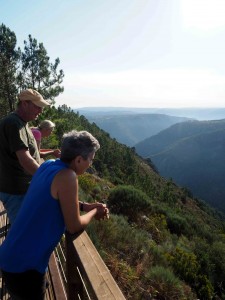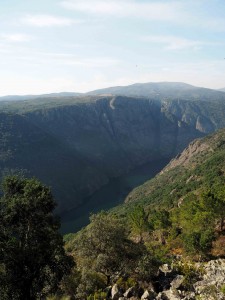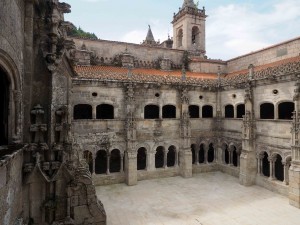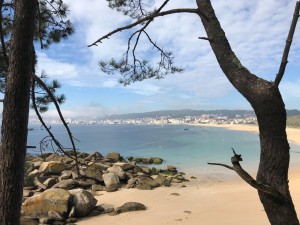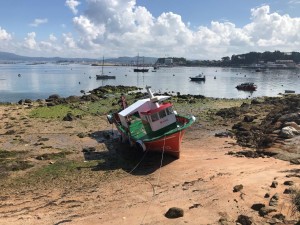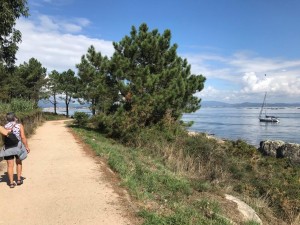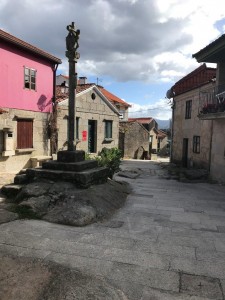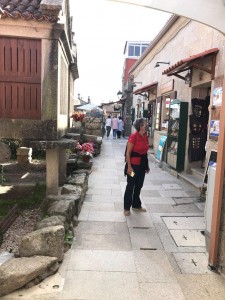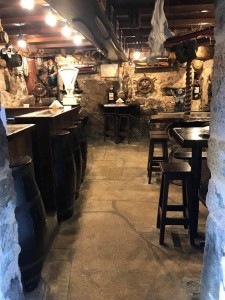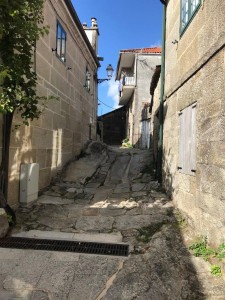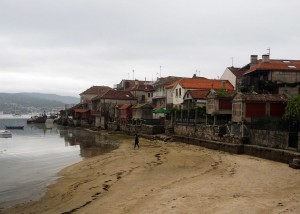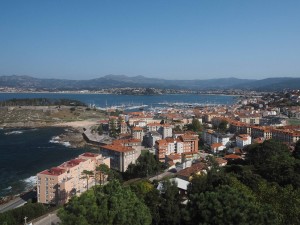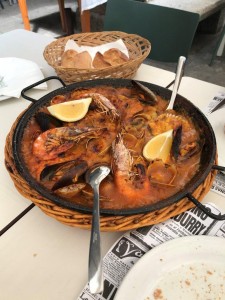We spent the whole of September in Spain – starting with a welcome weekend off the boat visiting Bas and Agnes in their new Spanish farmhouse, while Toodle-oo! was moored at Portosin Marina. Their new farmhouse is quite the place with lots of land with mature apple and fig trees and vines, a lovely old building with 2 kitchens plus a huge wood burning bread oven in it’s own dedicated shed – Laurie was swooning over it but apparently neither Bas nor Agnes are into the idea of becoming bakers! Their whole cruising plan aboard Tisento has been completely upended as their boat is still in Australia, but they’re not allowed in! So they purchased this place and plan to renovate in stages. We had a lovely weekend and they gave us a wonderful tour around the impressive scenery – so much more rugged than we had anticipated.
Once back on the boat, we moved just a short way south to an anchorage off a lovely beach and found ourselves surrounded by 6 other foreign boats – French, British and Swiss. We tried to get some social activity going with the Brits, but sadly, they were feeling rather exposed to C-19 and declined.
We dodged around various anchorages according to wind direction – which gave us opportunities to visit various different locales within Ria de Muros and finally returned to the first anchorage we’d visited: Ensenda de San Francisco which was convenient for our next hop south to Ria de Arousa – but the swell forced us to put out a stern anchor to keep the boat pointing into the swell – so as not to get kicked out of bed! Overnight, we got inundated with a bazillion tiny little black flies – the boat was covered in dead or dying bodies!
We motored south to Ria de Arousa, through a pretty narrow but easily navigated channel and anchored off the beach at Rubeira with 1 other boat. (I can imagine that in normal years there’d be more like 50 boats anchored here!) There’s a decent marina at Rubeiro, which we were able to use to land the dinghy and go walkabout. Ribeira is a larger town, not so touristy, but with good shopping opportunities.
On our second night at anchor, I was out in the cockpit and suddenly realized things were quiet – too quiet… the dinghy was gone! The painter was still attached to Toodle-oo! but the shackle at the dinghy had loosened up. I made a frantic call to the marina (at 10pm) and had a barely understood conversation with Manuel, but concluded that he didn’t understand… Not much to be done in the dark, so we went to bed… In the morning, I called the coast guard and after about 30 minutes of trying, finally managed to raise them. Half an hour later, I got a call back from them that the dinghy was located and would be towed back to Toodle-oo! in an hour… and an hour later it was tied alongside again!!! Turns out, Manuel, using binoculars the previous night had spotted the dinghy heading out towards the Atlantic, got into a rib and towed it back to the marina – where the coast guard “rescued” it the following morning! Needless to say, Manuel was thanked profusely and hopefully enjoyed the liquid goodies!
Once again, we moved anchorages according to wind direction, thereby getting a good looksee around the various aspects of the ria. Initially we headed up to Enseada do Caraminal where we anchored off another far too deserted beach where there were just three other boats anchored – including ‘Acid Rain’ with a young couple aboard, Alex and Irena, fresh out on a cruising experience…
Across the ria from there, there’s a little town Xufre, with an anchorage on north and south sides of a causeway-like feature… we were able to stay on the north anchorage – but it was rather bumpy with fishing boat traffic. Unfortunately the southern anchorage was too small to accomodate our final nights in Ria do Arousa, so we ended up moving back to Ribeira in preparation for our trip to the next ria.
We managed to actually sail to Ria de Pontevedra – almost right up to the very pretty town of Combarro – where we anchored close to Acid Rain again in just 2.5M of soft mud. Combarro is a beautiful old town with numerous little back alleys and cut-throughs with bars and restaruants hidden away – but sadly unpopulated due to C-19.
Our final stop in Spain was in Baiona where we anchored outside the marina. We’d been warned of sunken moorings which come up to attack at low tide – and indeed, one very large mussell infested buoy showed up the morning after our arrival, but fortunately just outside our anchoring circle!
The fort at Baiona is very impressive and must have been really interesting during it’s heyday. We enjoyed an overly priced drink at the hotel now situated within the fort’s walls – with a stunning view across the bay. We also managed to find an excellent Paella in town!!!
We’d have stayed a day or two longer in Baiona, but a weather window was very favorable for a trip south to Porto – a full day of sailng we were anxious to complete in daylight so that we could watch for fish pots – which apparently are all over the place on this passage…

